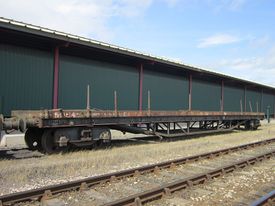GWR 60841 Bogie Bolster
| GWR 60841 Bogie Bolster | |
|---|---|
 GWR 60841 at Kidderminster (Gareth Price) | |
| Built By | GWR Swindon |
| Status | Awaiting overhaul |
| Number | 60841 |
| Other Numbers | DW60841 |
| History | |
| Built | 1935 |
| Diagram | J26 |
| Lot | 1214 |
| Type | Bogie bolster |
| Capacity | 40 tons |
| Telegraphic code | GANE A |
| 1975 | Arrived on SVR |
| 1985 | GWR 150 main line appearance |
Contents
Design and service
Within the GWR Diagram Book, Diagram J covered rail and timber bolster wagons, principally the MACAW and the larger GANE. The original GANE first built in 1899 as Diagram J1 was a 45ft bogie wagon with a 40-ton capacity. The introduction of 60ft rails in the late 1920s eventually saw a longer version introduced in 1935 as Diagram J26, still with a 40-ton capacity but with the length increased to 62ft over the headstocks. The same wagons produced under this Diagram were designated GANE A where used by the Engineering Department and MACAW J for other stock. Curiously, although 36 of the former were produced and only 10 of the latter, the code 'GANE A' did not appear in the 1939 Telegraph Message Code Book.[1]
60841 was built at Swindon in 1935 to Diagram J26 and saw service with the GWR and BR(W).
Preservation
60841 was purchased from Swindon by SVR(H) in July 1975.[2]
In 1985, 60841 appeared on the main line when it was used in the GW 150 demonstration freight train which ran to Newport behind GWR freight loco 2857.[3]
The wagon was re-decked by the Wagon Department in November 1988.[4] As of 2018[update] it is stored out of use awaiting overhaul.
See also
- List of goods wagons
- BR 996730 Rail Carrier (A BR-built version of the GANE A)
References
- ↑ Atkins, Beard & Tourret (2013) pp. 190-199, 209.
- ↑ SVR Stock Book Ninth Edition
- ↑ SVR News 78
- ↑ SVR News 92